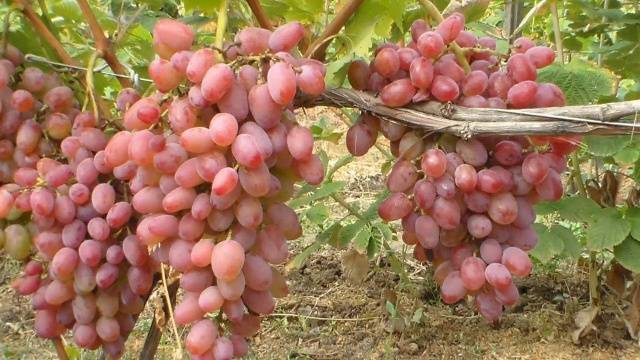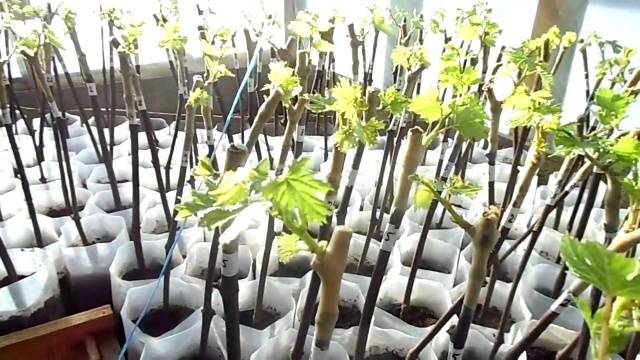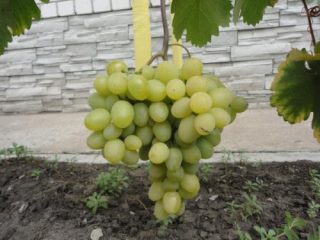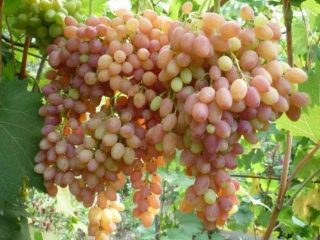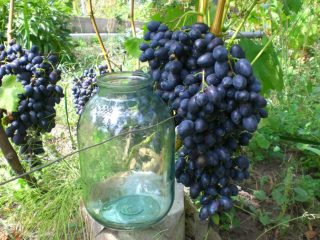Content
The dream of every winegrower is an unpretentious variety with large berries, beautiful clusters and excellent taste. Sooner or later, everyone faces the question of choice: white or blue, early or late, covering or winter-hardy. Unfortunately, it is rare to find grape varieties that have only advantages - but you have to put up with at least one drawback. Of the high-quality and popular varieties, Helios can be distinguished. The strengths of this grape: productivity, large size of bunches and berries, delicate muscat taste of the fruit, resistance to various diseases. Helios also has a small disadvantage: the variety is quite capricious and needs good care and nutritious soil.
Below is a description of the Helios grape variety, with photos and reviews from experienced gardeners. Here you can also find recommendations for planting and caring for vines, and learn about the strengths and weaknesses of the variety in more detail.
Hybrid characteristics
Helios is the brainchild of amateur breeder Krainov, who is the author of many popular varieties and hybrids in the country. In fact, Helios is a hybrid, its “parents” are Arcadia and Nakhodka sultanas.
Helios is a pink table grape with early ripening. Recommended for cultivation in regions with a mild climate - the southern part of the continent from Moldova to the Caucasus.In temperate climates, Helios also performs well, but the vine must be covered for the winter.
Description of the Helios grape variety:
- for Helios to fully ripen, it takes 110-115 days - usually ripe berries can be picked already in early August (by autumn the fruits gain even more sugar and become tastier, so you don’t have to rush to harvest);
- hybrid bushes are distinguished by their large height and high growth rate, so Helios is suitable for decorating hedges and gazebos;
- the shoots are colored golden brown, their internodes are red;
- the leaves are large, dark green, heavily indented;
- Helios flowers are bisexual (hermaphroditic);
- pollination of grapes goes well even in bad weather conditions;
- the Helios variety is characterized by a high level of shoot ripening, good rooting of cuttings, and compatibility with different rootstocks;
- the clusters of Pink Arcadia are large, shaped like a cone or a conical cylinder;
- the average weight of one bunch is 600-900 grams (clusters weighing 1.5 kg or more are often found);
- clusters are medium dense, not prone to peas;
- the berries are large, weighing about 13-15 grams;
- the shape of the fruit is oval, the peel is colored light red;
- the skin of the berries is dense, not prone to cracking, and is easy to chew while eating;
- there are one or two seeds in the grape pulp;
- the structure of the pulp is fleshy, dense, juicy;
- Helios has a nutmeg, sweet taste, with pleasant fruity and floral notes;
- the yield of the Helios variety is high, increasing even more with frequent feeding and proper care;
- the harvested crop is suitable for long-term storage and transportation over long distances;
- The frost resistance of the hybrid is average - without shelter the vine can withstand temperatures dropping to a maximum of -23-24 degrees;
- Helios has good immunity, this grape rarely suffers from oidium, phylloxera, mildew, and is not susceptible to various rots;
- a big advantage of the variety is its resistance to wasps - insects cannot damage the dense skin of the sweet berries;
- This grape hybrid is quite whimsical and needs good nutrition and constant care.
You can use the Helios harvest in different ways: eat large fresh berries, make rose wine, various juices, compotes or jams from grapes. The sugar content in fruits is high, its amount depends on the light and temperature during the ripening period.
Advantages and disadvantages
The Helios grape variety is very popular among private gardeners and summer residents. This hybrid is also chosen by large farmers who grow grapes for sale or for processing. This popularity is quite justified, because Pink Arcadia has a lot of advantages:
- high productivity;
- early maturation;
- excellent taste and high sugar content of berries;
- reluctance to peas, cracking and wasp attacks;
- immunity to the most common and dangerous diseases of grapes;
- good frost resistance;
- high commercial qualities (appearance, suitability for storage and transportation);
- ease of propagation and cultivation.
The winegrower must remember that Helios is a very capricious variety.These grapes will definitely “notice” any errors in care and cultivation and will react with a decrease in yield, deterioration in the quality and taste of the berries, and poor condition of the vine.
Planting a capricious hybrid
Helios must be planted in the right place. This should be a well-lit area with natural protection from the north wind in the form of a house wall, outbuilding, fence or gazebo. Thanks to the strong growth and branching of the shoots, Helios grapes will be an excellent decoration for the garden or local area. The soil at the planting site must be fertile, loose, and well-permeable to moisture and air.
It is equally important to choose high-quality planting material. Helios cuttings should be strong and healthy, with a well-developed root system without signs of damage or infection.
Before planting, grape cuttings should be prepared:
- Rejuvenate the root system of the cuttings by trimming their roots by about 10 cm.
- Choose the longest and strongest shoot (if there are several of them on the seedling), cut out the remaining shoots.
- Trim the remaining main grape shoot to the fourth or fifth bud.
- A day before planting, place the root system of the grapes in water or a growth stimulator.
The time for planting Helios grapes can be chosen either in spring or autumn. If planting in autumn, you will definitely need to cover the seedling for the winter to prevent it from freezing.
It is advisable to prepare pits for planting grapes in advance (optimally, six months before planting cuttings). The distance between neighboring Helios bushes should be about 2.5-3 meters, since the variety is vigorous and spreading. The dimensions of the planting pit are slightly larger than standard: 80x80x80 cm.
During the planting process, it is very important to correctly distribute the soil layers. The top layer (about half) is removed from the pit and mixed with fertilizers: superphosphate, potassium salt, humus or compost. After this, the fertilized soil is placed at the bottom of the hole (a layer about 35 cm in height should form) and the grape cutting is placed on it.
The roots of the grapes are carefully straightened, making sure that they are not directed upwards. Then the Helios root system is sprinkled with soil from the second, lower, layer of soil. The soil around the grapes is thoroughly compacted.
After planting, you need to water the grapes regularly, pouring about 25 liters of water per square meter of soil. Before watering, the soil must be loosened or the hole filled with mulch material.
Competent care
As already mentioned, the Helios grape variety needs competent and correct care - this hybrid does not forgive mistakes. In principle, the stages of care are the same as usual, but here it is important to follow the instructions and do everything in a timely manner.
Helios grapes need the following:
- Water Pink grapes need to be grown very carefully. For Helios, both a lack of moisture and its excess are equally dangerous.In early spring, the vine needs to be watered as soon as the thermometer stays above zero. At sub-zero temperatures, do not water the grapes, as this may cause their roots to freeze. The second time Helios is watered immediately after spring pruning, you need to pour about 30 liters per square meter. Before flowering and after it, at the stage of berry formation, the vine is watered several more times. The last watering should take place before wintering, then the amount of water is increased to 50 l/m2. It is important to understand that artificial irrigation is only necessary during periods of drought when natural rainfall is insufficient.
- To retain moisture at the roots and protect the root system of grapes from overheating, it is recommended use mulch. Dry leaves, straw, mown grass, sawdust, humus or peat are poured in a thick layer (about 5 cm) around the vine.
- High-yielding Helios grapes need high-quality pruning and rationing, otherwise its shoots may break and the berries will become smaller. Pruning should be done in early spring, before sap flow begins in the vine. Each shoot should be shortened to a maximum of seven eyes. On each adult bush, in total, there should be 35-40 buds.
- Feeding for Helios they must be regular and quite abundant. Mineral fertilizers should be applied to the soil at least once a year. Once every three years, organic matter is usually added. The optimal feeding regimen is as follows: ammonium nitrate in early spring, before and after flowering - superphosphate and potassium salt, in between - watering with the addition of organic matter (slurry, bird droppings, wood ash).
- Disease and pest control should be reduced to prevention, especially since Helios is not susceptible to infection. It is effective to treat the vine before and after flowering with fungicidal agents, such as Bordeaux mixture, for example. Wasps are rarely tempted by Helios berries, but if this happens, the bunches can be placed in special protective nets.
- In regions with harsh or snowless winters, grapes needs to be covered. Usually, each bush is divided in half, the vine is tied and laid on the ground, previously covered with agrofibre. Each half of the bush must be pinned to the ground. Metal arcs are installed over the grape shoots, which need to be covered with film. You can also use the ground for shelter, but this method is more suitable for regions with snowy winters.
If everything is done correctly, Helios clusters will grow the same as in the photo. Reviews from winegrowers about this variety are mostly positive, so there should be no problems with the pink hybrid.
Review
Conclusion
Pink Helios grapes are perfect for winegrowers from southern regions with a mild climate and relatively cold winters. Probably, this variety should not be planted by those who are just starting to grow wine berries, and by those who do not have time to care for the vineyard.Otherwise, the Pink Arcadia hybrid is very good: the yield is high, it rarely gets sick, and it bears fruit in large and beautiful clusters.
